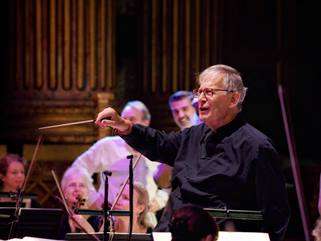|
Back
Standing and Outstanding New York
Carnegie Hall, Stern Auditorium
02/21/2020 - & February 11 (Barcelona), March 2 (Chicago), May 14 (London) 2020
Ludwig van Beethoven: Symphony No. 4 in B-flat Major, Op. 60, & No. 5 in C minor, Op. 67
Orchestre Révolutionnaire et Romantique, Sir John Eliot Gardiner (Artistic Director and Conductor)

J. E. Gardiner (© Pascal Le Mée)
“Beauty is truth, truth beauty”
Keats
The argument rages and that is a good thing. Should the works of the past be presented in as close to their original forms as is humanly possible or should they be offered in more modern versions? The answer: both, thank you.
Gun to head I prefer the modern versions, but I can recall being very disappointed that the American Symphony performed Mahler’s 7th thusly:
“It was less understandable why, in a performance meant to emphasize the idea of memory, the opening, crucial tenorhorn solo, meant by its rough timbre to evoke the childhood love of the composer for military band music, was played on the more "acceptable" euphonium, an orchestral instrument with a smooth sound perhaps best known for its featuring passages in Holst’s The Planets. Very jarring to a Mahlerite ear, when the player botched the solo’s reprise it seemed poetic justice.”
ConcertoNet, 10/20/2000
Sir John Eliot Gardiner is a rebel with a cause, touring the world presenting the works of Beethoven in their “original” performing condition. Quite a tall man, he, unlike Michael Bloomberg, is allowed to stand on a box while making his case for authenticity. His troops are decided throwbacks, the violins and violas standing throughout and the variety of instruments at his disposal quite impressive. We were treated to natural horns (valveless), a contrabassoon that towered over its instrumentalist, hard stick tympani and a visual aura of commitment to a past long forgotten. The Symphony No. 4 was presented with precision but also with a sense of animalistic gravitas. Parenthetically, there was not an empty seat in all five levels of Carnegie Hall.
What to do for an encore? Maestro’s sense of the dramatic was presented when the orchestra came out for the Symphony No. 5 and virtually all of the players except the cellos and basses were standing for the duration. It was as if a military band has taken the place of the ensemble for this most powerful of works.
The ploy worked as if by magic. This was a superb and oddly disturbing performance, painfully making us not just listen with attention but also forcing us all to rethink our core beliefs of presentation and instrumentation. The opening Allegro con brio was intoned at a breakneck pace. In fact all of the extremely familiar movements (what work in the entire literature is more a part of our collective musical soul?) was presented as if all pretention was stripped away and only the core was left to entertain and challenge us all. Except for a rather sing-song traversal of the third movement Allegro this was as good as it gets. Friends who have been attending the entire series are simply knocked out by this maestro and his merry band.
Carnegie Hall is graciously offering the complete Beethoven cycle not once but twice in this special 250th birthday year, first with original instruments and then with modern. Others can review the rest of this initial series while the Philadelphia Orchestra will later employ its contemporary instrumentation. After all, can one really perform Symphonie fantastique without an ophicleide?
Fred Kirshnit
|